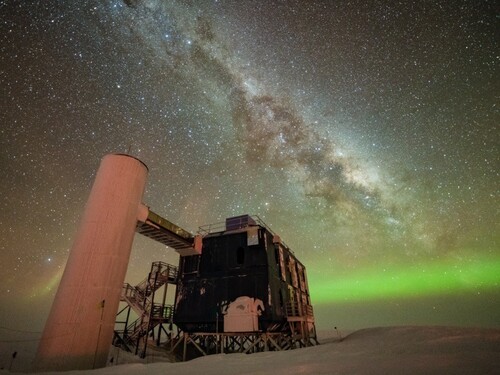

Neutrinos are the most elusive of the fundamental particles, and come in three types: the electron neutrino, the muon neutrino and the tau neutrino. Almost massless and lacking electric charge, they interact with matter only through a fundamental force known as the weak interaction, which is mediated by force-carrying particles called W and Z bosons. In 1959, the theoretical physicist Sheldon Glashow used the standard model of particle physics to predict1 that negatively charged W bosons (W− bosons) can be formed in the collisions between an electron and an electron antineutrino (the antimatter version of an electron neutrino). This process is now called the Glashow resonance, and occurs for electron antineutrinos that have energies of about 6.3 petaelectronvolts (1 PeV is 1015 eV).
The Glashow resonance has not been observed in laboratories, because the antineutrino energy required is beyond the range of currently available particle accelerators. However, naturally occurring antineutrinos that are produced in cosmic processes can reach energies up to tens of PeV2. In a paper in Nature, the IceCube Collaboration reports the detection of an event produced by an antineutrino from an astrophysical source, which could be the first observation of the Glashow resonance3.
When a neutrino interacts with matter, charged particles are produced. These emit light known as Cherenkov radiation when they travel through a transparent medium (such as ice or water) at a speed greater than the speed of light in that medium. High-energy astrophysical neutrinos can thus be observed by instruments that detect Cherenkov radiation in such a medium. Because the expected fluxes in the number of astrophysical neutrinos at the energy levels of interest are low, and these fluxes are thought to decrease rapidly as the energy of neutrinos increases2, large volumes of the transparent medium are needed.
The IceCube Neutrino Observatory is a neutrino detector buried in the deep ice near the Amundsen–Scott South Pole Station in Antarctica (Fig. 1). Its main goal is to observe neutrinos produced from the most powerful astrophysical sources in the Universe, such as active galactic nuclei and γ-ray bursts, or from cataclysmic phenomena such as exploding stars and mergers of black holes or neutron stars. IceCube can detect all flavours of astrophysical neutrino, at energies beyond the exaelectronvolt range (1 EeV is 1018 eV). It consists of 5,160 digital optical modules (DOMs; devices capable of detecting faint light signals), arrayed over one cubic kilometre of Antarctic ice, buried at depths of 1,450–2,450 metres. The DOMs are attached to 86 vertical strings spaced 125 metres apart in the ice, deployed on a hexagonal grid.

Figure 1 | The IceCube Neutrino Observatory, Antarctica. The IceCube Collaboration reports3 evidence of an event known as a Glashow resonance, which occurs when a high-energy electron antineutrino (the antimatter counterpart of an electron neutrino) interacts with matter.Credit: Yuya Makino, IceCube/NSF
Cherenkov radiation detected by the DOMs is used to reconstruct the properties of the neutrino that triggered it — such as its energy, and the direction from which it arrived. The topology of the radiation burst can also be instructive. For example, when a muon neutrino interacts with matter, it can create a muon particle that travels several kilometres4. This produces an elongated, luminous trajectory in the ice called a track. Other neutrino flavours produce cascades of secondary particles within a spherical region just 10 metres in diameter5. The spatial and temporal features of detected light signals thus contain information about the neutrino flavour, and about the interaction channel (the process by which the neutrino interacted with matter; the Glashow resonance is one type of interaction channel).
Antineutrinos that interact with matter through the Glashow resonance are expected to produce characteristic events in which the resulting W− boson decays into a cascade of secondary particles, including particles called hadrons. Roughly 5% of the neutrino energy in these events is expected to be taken up by secondary particles that are neutral or don’t have enough energy to produce Cherenkov radiation5, limiting the amount of energy that can be observed to about 6.0 PeV. Moreover, low-energy muons are expected to be produced in the cascade, and to outrun the wavefront of the Cherenkov radiation at a high enough rate to trigger early pulses of light that would be detected by the DOMs.
On 8 December 2016, IceCube detected an event that had a visible energy of 6.05 ± 0.72 PeV. The IceCube Collaboration analysed the parameters of the event using a machine-learning algorithm that had been optimized to recognize cascades that have multi-PeV energies. The algorithm had been trained to discriminate such signals from those associated with muons produced in the atmosphere, taking into account differences between track and cascade events.
On the basis of the characteristics of the detected event, the authors classified it as having been caused by an astrophysical neutrino — the confidence of this classification was at the 5σ level, which means that there is only about one chance in three million that it is wrong. Moreover, early light pulses were detected by the DOMs, consistent with the production of low-energy secondary muons from the decay of a W– boson into hadrons. A statistical test of the data indicated that the neutrino-interaction process that caused the event could be the Glashow resonance. However, the confidence of that result is only at the 2.3σ level, which falls some way short of completely ruling out the possibility of a non-Glashow-resonance event.
Nevertheless, the IceCube Collaboration’s observations are cause for celebration, because they are the first to be consistent with a Glashow resonance. An unambiguous detection would not only provide further confirmation of the standard model of particle physics, but also prove that electron antineutrinos are present in astrophysical fluxes. The fraction of astrophysical fluxes that consists of electron antineutrinos will depend on the mechanisms by which neutrinos and antineutrinos are produced, of which there are two possibilities6: hadronuclear processes, which involve proton–proton interactions, and photohadronic processes, which involve proton–photon interactions. Future measurements of electron antineutrinos will therefore open a window on the physics of neutrino sources. The current IceCube detector can detect only a low number of Glashow-resonance events, but the next generation of the apparatus — IceCube-Gen2 — was proposed last year7. This detector will have a sufficiently large volume of sensor-probed ice to observe higher numbers of Glashow-resonance events, thus enabling a statistically meaningful analysis of astrophysical neutrino-production mechanisms.
